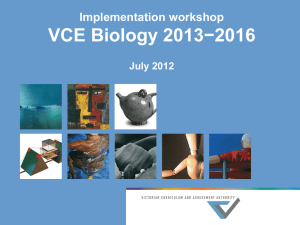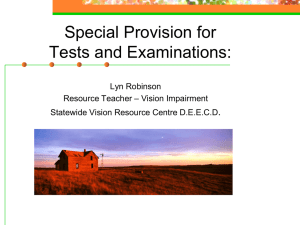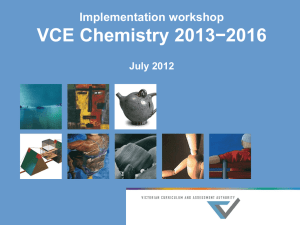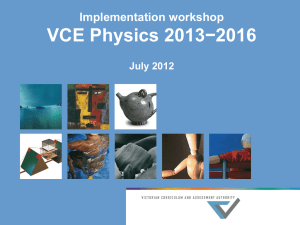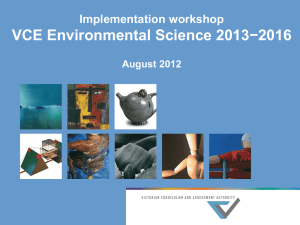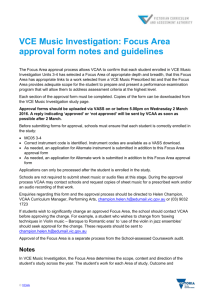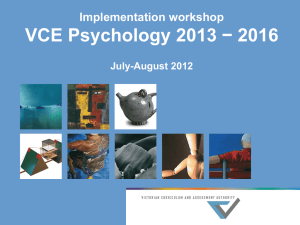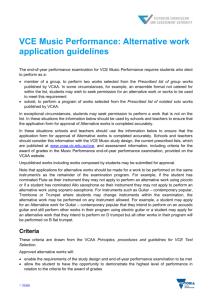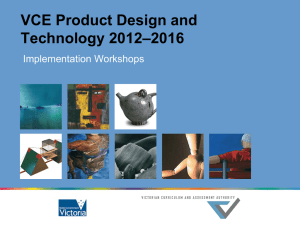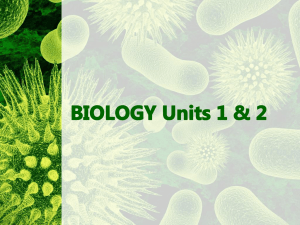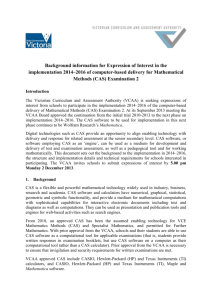VCE Biology 2013−2016 - Victorian Curriculum and Assessment
advertisement
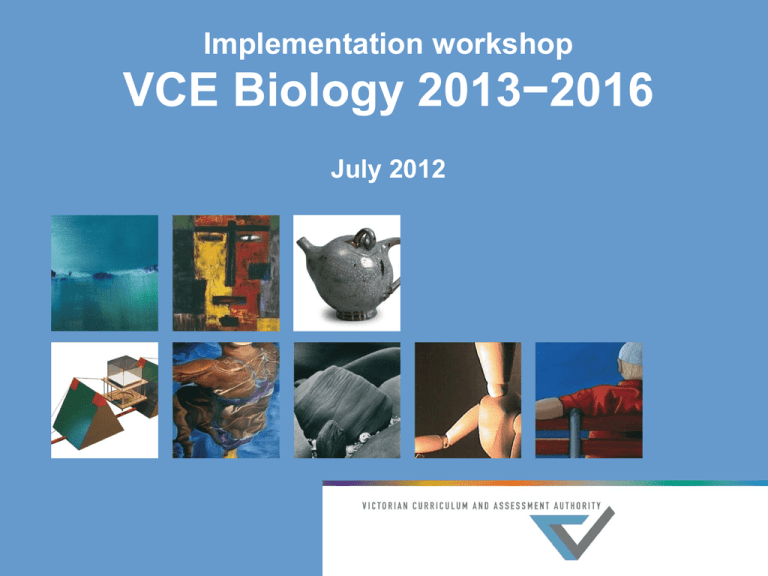
Implementation workshop VCE Biology 2013−2016 July 2012 Purpose The aims of this session include: • to provide specific information regarding changes to curriculum and assessment for VCE Biology 2013−2016 as a result of a move to a single end-of-year examination of two-and-ahalf hours duration • to gather feedback/questions/comments regarding implementation in order to produce a set of FAQs to support delivery of the revised study design for VCE Biology from 2013. Online publication of VCE Study Designs • From 2013, all VCE study designs, advice for teachers, resources and assessment handbooks will be available in an online format only (i.e. no hard copies) • Online publications will include a publication/update date • Teachers will be advised of major updates through the VCAA Bulletin VCE, VET and VCAL Summary of changes A number of key knowledge points across Units 3 and 4 have been edited for clarity and scope, and changes have been made to School-Assessed Coursework. These have been published in the VCAA Bulletin VCE, VCAL and VET Supplement 1, No. 97, July 2012. Reminder: teachers may subscribe to the VCAA Bulletin Online – refer to VCAA home page. Teaching and learning resources • Changes to the study design have been made with the intention that teachers may continue to use existing teaching and learning resources • The Summary of changes for VCE Biology on the VCAA website should assist teachers to identify study content and sections in current texts which may no longer be applicable to the accredited 2013–2016 course • Teachers should note that some publishers are producing revised materials. It is a school/teacher-based decision as to whether new resources are purchased and/or utilised Overview of changes Curriculum changes: • Greater specification of extent of key knowledge points to clarify scope, for example: - photosynthesis excluding CAM, C3 and C4 plants - coordination and regulation at the cellular level - apoptosis moved to Unit 3, linked to regulation Assessment changes: • Single end-of-year examination of 2½ hours duration • Examination:SAC = 60:40 (changed from 66:34) • SAC tasks and mark allocations have changed • Increased focus on practical work Changed Unit 3 Outcome Current Unit 3, Outcome 2: On completion of this unit the student should be able to describe and explain coordination and regulation of an organism’s immune responses to antigens at the molecular level Revised Unit 3, Outcome 2: On completion of this unit the student should be able to describe and explain the use of the stimulus-response model in coordination and regulation and how the components of the human immune system respond to antigens and provide immunity Changed Unit 4 Outcome Unit 4, Outcome 2: On completion of this unit the student should be able to analyse and evaluate evidence for evolutionary change and evolutionary relationships, and describe mechanisms for change including the effect of human intervention on evolutionary processes through selective breeding and applications of biotechnology Key Knowledge: deletion and modification Examples Deletion • Deletion of the key knowledge dot point: “applications of molecular biology in medicine including the design of drugs and in medical diagnosis” Modification • Rational drug design is linked directly to enzyme action: Current: enzymes as organic catalysts Revised: the role of enzymes as protein catalysts, their mode of action and the inhibition of the action of enzymes both naturally and by rational drug design Key knowledge elaboration: Unit 4, AOS2 Current: • hominid evolution: patterns, origin • interrelationships between biological, cultural and technological evolution Revised: • hominin evolution: - shared characteristics which define primates, hominoids and hominins - major trends in hominin evolution from the genus Australopithecus to the genus Homo including morphological, structural and cognitive development resulting in cultural evolution and the rise of technologies FAQs A set of Frequently Asked Questions will be published on the VCE Biology study page of the VCAA website to support implementation of the revised study design 2013−2016 School-assessed Coursework • contributes 40 per cent to the study score - Unit 3 SAC: 20 per cent - Unit 4 SAC: 20 per cent • should form part of the teaching and learning program, both in terms of formative (including diagnostic) and summative assessment School-assessed Coursework: Practical investigations • • Assessment tasks include reports of three practical activities in Unit 3 and 4 - values practical work - supports an inquiry approach (continuum from teacherled inquiry through to student-designed experiments) - develops key skills (refer to page 12 of study design) Given the topics in Unit 4, the investigative nature of ‘practical activities’ may involve the use of data, simulations and/or models as an alternative to laboratory experiments, in line with available school resources Advice for Teachers • The Advice for Teachers has been updated to include relevant employability skills derived from the Employability Skills Framework against specified assessment tasks for Units 1−4 Assessment Handbook The Assessment Handbook for VCE Biology 2013−2016 will be available from the VCE Biology study page prior to Term 1 2013. Resources • The list of resources will be updated annually by the VCAA and will be available from the VCE Biology page • Educators may submit suggested references for inclusion on the resource list to the Curriculum Manager for Science at the VCAA Examination conditions • 15 minutes reading time • 150 minutes writing time • Question and Answer book + Multiple Choice answer sheet • 60 per cent contribution to Study Score Examination content • • • • All outcomes in Units 3 and 4 All the key knowledge and key skills Students will be required to apply Biology knowledge and skills to both Unit 3 and to Unit 4 Some questions may include content from more than one Area of Study within a Unit and/or content which may cross both Unit 3 and 4 Examination format and mark allocation Two sections • Section A - 40 multiple-choice questions - one mark each • Section B - short answer questions - 70 marks total Examination will be out of 110 marks Section A TOTAL MARKS: 40 • multiple choice • all questions compulsory • all Areas of Study will be approximately equally represented • some questions built around a scenario • questions will be answered on a Multiple Choice answer sheet Section B TOTAL MARKS: 70 • short answer questions • students will respond to a series of items related to all four areas of study in Units 3 and 4 • all questions will be compulsory • content of some questions may cross Units 3 and 4 Approved examination materials Approved: • Stationery: pens, pencils, highlighters, erasers, sharpeners and rulers Not approved: • Blank sheets of paper • Correction fluid • Calculator Examination Advice • • • The examination will follow the examination specifications and will test a representative sample of the key knowledge and key skills The number of marks provides a guide to the complexity of the expected answer/s Students may be asked to draw on their practical experience when answering questions Sample examination paper • • • • • Sample examination paper is composed largely of past examination questions Solutions to past examination questions can be accessed by referring to the relevant Assessment Reports available on the VCAA website Some questions were specifically developed to illustrate that questions can draw upon understanding of concepts across Units 3 and 4 Students may be asked to draw on their practical experience when answering questions Sample examination paper will be published on the VCE Biology study page of the VCAA website Contact VCAA branch Science Manager Contact Details Curriculum Maria James Tel: 9651 4655 Email: james.maria.m@edumail.vic.gov.au Assessment Simona Wengritzky Tel: 9225 2357 Email: wengritzky.simona.d@edumail.vic.gov.au © Victorian Curriculum and Assessment Authority 2012

